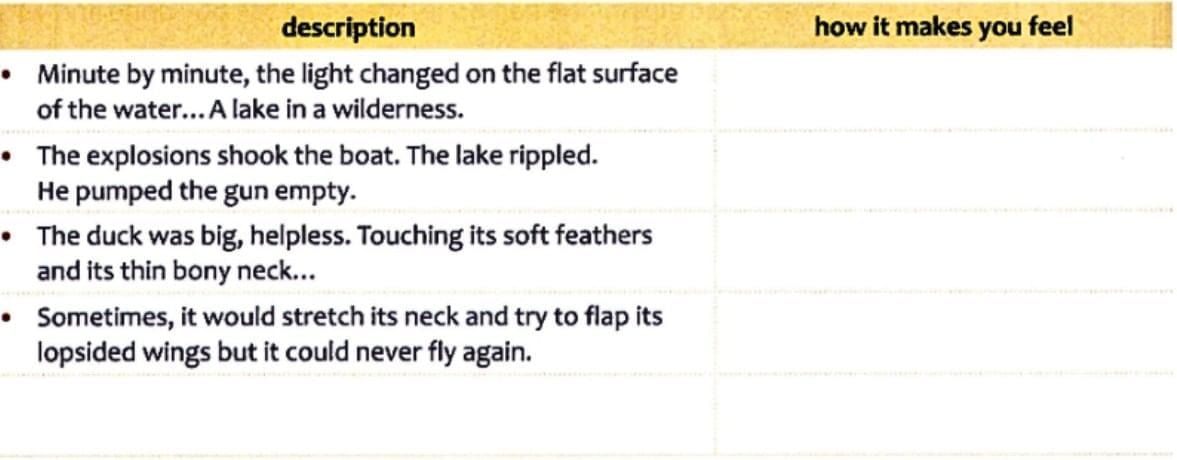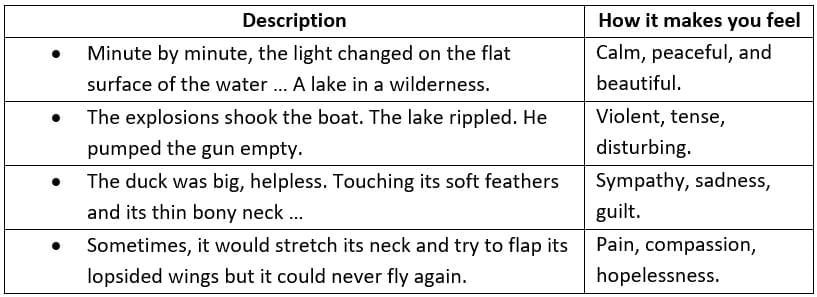Textbook Solutions: Wild Duck | Gul Mohar Class 6: Book Solutions, Summaries & Worksheets PDF Download
| Table of contents |

|
| Before You Read |

|
| While Reading |

|
| Understanding the Text |

|
| Appreciating the Text |

|
Before You Read
Q1. What did they teach you—an activity, a rule of good behaviour or something else?Ans: They taught me how to cycle.
Q2. Why do you remember it—why was the experience special?
Ans: It was the first skill I learnt on my own and gave me independence.
Q3. Have you ever taught a grown-up anything? What did you teach them and how?
Ans: Yes, I once taught my parents how to use a mobile app by showing them step by step.
While Reading
Q1. Till para 10, the boy hardly speaks. Why do you think he is so quiet?Ans: He is nervous, observing carefully, and listening to his father’s instructions.
Q2. Why do you think the writer provides such detailed and beautiful images of nature? (paras 11–13)
Ans: To show the boy’s wonder and fascination, and to highlight the contrast between beauty and violence.
Q3. Do you notice any change in the boy from para 11 onwards? What is it?
Ans: Yes, he shifts from being passive and quiet to becoming active and excited when the birds appear.
Q4. Why do you think the boy wants to find the bird? What does he plan to do?
Ans: He wants to rescue it. He plans to take it home and care for it.
Q5. Point out the comparison in para 26 and explain it.
Ans: The broken wing of the duck is compared to a ragged sail of a toy boat. It shows helplessness and fragility.
Q6. Why does the writer use the word ‘sick’ to describe how the boy feels? Would the word ‘angry’ or ‘sad’ have the same effect?
Ans: ‘Sick’ shows a deep, physical revulsion at violence, stronger than anger or sadness.
Understanding the Text
A. Give reasons for these statements.
Q1. The boy watched the birds in fascination.Ans: He loved watching birds and was spellbound by their flight.
Q2. The man could tell the boy how and which way the birds would move.
Ans: He was experienced at hunting and could read their patterns.
Q3. The colours of the lake changed from para 6 to para 13.
Ans: The sky and light kept changing with birds and sunset.
Q4. The boy took the duck home.
Ans: He felt responsible for wounding it and wanted to care for it.
Q5. The boy threw his gun away.
Ans: He rejected violence and killing after his experience.
Q6. In para 43, the man felt two different emotions one after the other.
Ans: First anger at the boy’s boldness, then relief that the gun was gone.
B. Answer these questions.
Q1. How does the story open—what can you see and where? (paras 1 to 10) What kind of mood does it set?Ans: It opens with father and son waiting silently in a boat with guns. The mood is tense, expectant, and serious.
Q2. (a) His arms trembled as he pulled the paddle through the black water. (para 24) What had happened just before this? Why was the boy paddling?
Ans: He had shot a bird, so he was paddling to retrieve it.
Q2. (b) Why do you think his arms trembled? Which para shows a change in this feeling?
Ans: He was nervous and shaken by his action. His relief shows in para 32 when he sees the duck alive.
Q3. … the boy looked frightened at what he had done. What had the boy done and why was he frightened by it? (paras 20, 21 and 29)
Ans: He had shot a bird. He was frightened because he had harmed a living being.
Q4. (a) “You’ll have to look after it.” (para 34) Do you think the man wanted the boy to look after the duck? What makes you think so?
Ans: Yes. His words suggest he accepted the boy’s compassion and responsibility.
Q4.(b) Has the man been mentioned in para 36? Why do you think the writer did this? Does it support your answer to question 4a.?
Ans: No. To show the boy’s independence and personal care for the duck, without his father’s guidance. Yes, it supports the answer to 4a.
Q5. (a) “I threw it away,” he said defiantly. (para 38) What was the boy’s state of mind when he said this? Why do you think he spoke this way?
Ans: He was determined, bold, and rejecting violence. He wanted to assert his decision.
Q5. (b) Do you agree with what the boy did? Why or why not?
Ans: Yes. It shows moral courage, a stand for non-violence, and responsibility.
Q6. Read the last line of the text. What can we guess about the man from this line that has not been directly said anywhere? (para 43)
Ans: That deep down, he too felt relief at ending violence and was ready to accept peace.
Q7. How does this text encourage ahimsa or non-violence? Explain based on these points.
a. What is the act of violence in the story and what is its direct outcome?
Ans: Shooting the duck; its outcome is injury and guilt.
b. How do the characters feel when they decide to stop doing something violent?
Ans: They feel peace and relief, showing the power of non-violence.
Appreciating the Text
Q1. In a story, a writer may show a struggle between characters, ideas and thoughts that are not alike. This struggle is called a conflict and can occur.....- within the character's minds, when they feel torn between two opposite feelings
- between two or more different characters with different ideas
- between characters and the situations that they find themselves in.
Read the story carefully. Find an example each to show a conflict that occurs—
a. within the minds of the boy and the man.
Ans: Boy—feels pride in shooting but also guilt. Man—feels anger at losing the gun but later peace.
b. between the boy and the man.
Ans: When the boy throws away the gun, defying his father.
Q2. Writers use metaphors to show comparisons between things that are not usually connected to each other, without using 'as' or 'like'. For example, the man says that the birds come in clouds. Here, a comparison is being made between flocks of birds and clouds. He does not mean that the birds actually arrive in clouds. Instead, what he is trying to say is that they come in such large numbers that they appear to form huge clouds.
Pick another metaphor used to describe the ducks and explain what it means.
Ans: “They come in clouds” compares the huge flocks of birds to clouds, showing their number and movement.
Q3. Look at the table on the next page. Complete it by writing how these descriptions from the text make you feel. You can add another description that you love, from the text.
Ans: 
|
30 videos|61 docs|17 tests
|
FAQs on Textbook Solutions: Wild Duck - Gul Mohar Class 6: Book Solutions, Summaries & Worksheets
| 1. What is the central theme of "Wild Duck"? |  |
| 2. Who are the main characters in "Wild Duck"? |  |
| 3. How does "Wild Duck" reflect social issues of its time? |  |
| 4. What role does symbolism play in "Wild Duck"? |  |
| 5. How does the ending of "Wild Duck" impact the overall message of the play? |  |















